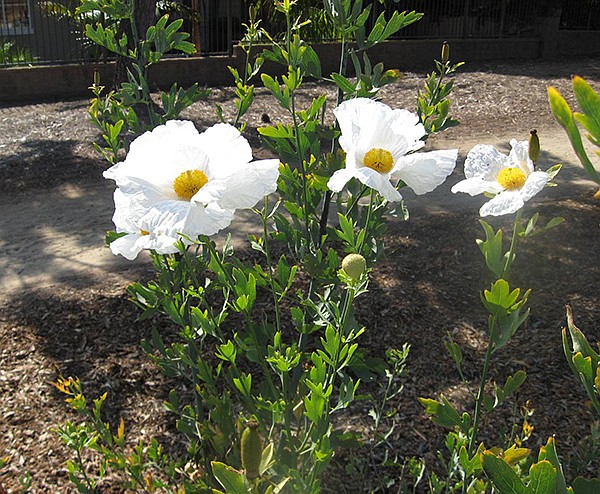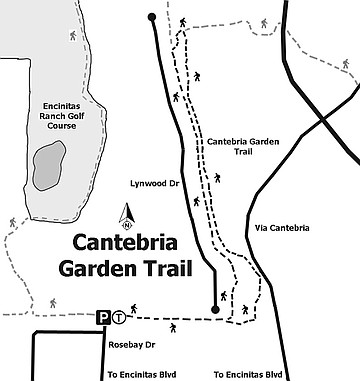 Facebook
Facebook
 X
X
 Instagram
Instagram
 TikTok
TikTok
 Youtube
Youtube

You will be pleasantly surprised to discover so many varieties of California native plants along this short urban canyon walk. This is an easily accessed trail, welcoming all levels. The trail is popular with neighbors and their leashed dogs, yet is never crowded. Bikes are rarely encountered.
The Cantebria Trail is part of the 9.5-mile Encinitas Ranch trail system that was included in the design of the 850-acre development in 1994. Previously, the property was part of the Paul Ecke Ranch, known for its world-famous poinsettias. The Eckes began their business in Hollywood and moved to Encinitas in 1923, originally growing their poinsettias outdoors. In the 1960s, they began growing indoors and selling cuttings. Then, in the 1990s they faced a lot of competition and began growing their poinsettias offshore in Guatemala and sold part of their ranch holdings, which were developed into the Encinitas Ranch. Unfortunately, the Eckes were not able to keep up with the competition. Paul Ecke III sold his poinsettia operation in 2012.

When this part of the Ecke Ranch was developed by Encinitas Ranch, the land surrounding the Cantebria Trail was left undisturbed. There are mature laurel sumac, Mission and Del Mar manzanita, lemonadeberry, mountain mahogany, and yerba santa along the trail. Large ceanothus and Torrey Pines are easily spotted a short distance from the trail. Begin the walk by going up the hill from the end of Rosebay Drive; at the top of the hill, take the path to the right at the Y-junction to descend. It’s a bit steep here but levels off shortly.
While coastal breezes keep Cantebria Trail pleasant year-round, the best time for color is March and April. In spring, there is wolfberry, wild hyacinth, spice bush, monkey flower, and Johnston’s honeysuckle in bloom. Deerweed shows off spectacularly, and the scent of sagebrush fills the air. In summer and fall, there may be San Diego wreathplant (Stephanomeria diegensis), Del Mar aster, tarplant, cobwebby thistle, and elderberry. Mountain mahogany with its many feathery-plumed fruit distinguish this rose family member from the surrounding scrub-like trees.
Cottontails dart across the trail in twilight hours. Scat gives away the presence of coyote. Finches chatter away as they forage among the sagebrush, chamise, and black sage. California towhees are nearly always visible. Wrentits and bushtits keep in touch with each other. In the spring, you will hear — and, if really lucky, see — grosbeaks calling to each other.
To make this a loop walk, turn left at the “T-junction” and walk up the hill. At the end of the canyon trail are Torrey Pines on a flat trail abutting the Encinitas Ranch houses. From here, views of the San Bernardino Mountains can be particularly exhilarating on a clear day after snowfall in the higher altitudes. Otherwise, turn around to retrace your steps where there may be plants not noticed on the way out!

Distance from downtown San Diego: 28 miles. Allow 30 minutes driving time in light traffic (coastal Encinitas). Take I-5 North to the Encinitas Blvd. exit. Turn right (east) on Encinitas Blvd. and travel for 0.5 mile. Turn left at Rosebay Dr. Continue to the end of Rosebay Dr. and park on the street. The trail is to your right and goes up the hill.
Hiking Length: 2 miles round-trip.
Difficulty: Easy. Elevation gain/loss about 50 feet. The trail is relatively flat in a coastal canyon, although one short section of trail is a bit steep. The trail runs parallel to Via Cantebria, and early in the hike there is some traffic noise. Dogs (on leashes) and bikes allowed. There is evidence of equestrian use. No facilities or water.


You will be pleasantly surprised to discover so many varieties of California native plants along this short urban canyon walk. This is an easily accessed trail, welcoming all levels. The trail is popular with neighbors and their leashed dogs, yet is never crowded. Bikes are rarely encountered.
The Cantebria Trail is part of the 9.5-mile Encinitas Ranch trail system that was included in the design of the 850-acre development in 1994. Previously, the property was part of the Paul Ecke Ranch, known for its world-famous poinsettias. The Eckes began their business in Hollywood and moved to Encinitas in 1923, originally growing their poinsettias outdoors. In the 1960s, they began growing indoors and selling cuttings. Then, in the 1990s they faced a lot of competition and began growing their poinsettias offshore in Guatemala and sold part of their ranch holdings, which were developed into the Encinitas Ranch. Unfortunately, the Eckes were not able to keep up with the competition. Paul Ecke III sold his poinsettia operation in 2012.

When this part of the Ecke Ranch was developed by Encinitas Ranch, the land surrounding the Cantebria Trail was left undisturbed. There are mature laurel sumac, Mission and Del Mar manzanita, lemonadeberry, mountain mahogany, and yerba santa along the trail. Large ceanothus and Torrey Pines are easily spotted a short distance from the trail. Begin the walk by going up the hill from the end of Rosebay Drive; at the top of the hill, take the path to the right at the Y-junction to descend. It’s a bit steep here but levels off shortly.
While coastal breezes keep Cantebria Trail pleasant year-round, the best time for color is March and April. In spring, there is wolfberry, wild hyacinth, spice bush, monkey flower, and Johnston’s honeysuckle in bloom. Deerweed shows off spectacularly, and the scent of sagebrush fills the air. In summer and fall, there may be San Diego wreathplant (Stephanomeria diegensis), Del Mar aster, tarplant, cobwebby thistle, and elderberry. Mountain mahogany with its many feathery-plumed fruit distinguish this rose family member from the surrounding scrub-like trees.
Cottontails dart across the trail in twilight hours. Scat gives away the presence of coyote. Finches chatter away as they forage among the sagebrush, chamise, and black sage. California towhees are nearly always visible. Wrentits and bushtits keep in touch with each other. In the spring, you will hear — and, if really lucky, see — grosbeaks calling to each other.
To make this a loop walk, turn left at the “T-junction” and walk up the hill. At the end of the canyon trail are Torrey Pines on a flat trail abutting the Encinitas Ranch houses. From here, views of the San Bernardino Mountains can be particularly exhilarating on a clear day after snowfall in the higher altitudes. Otherwise, turn around to retrace your steps where there may be plants not noticed on the way out!

Distance from downtown San Diego: 28 miles. Allow 30 minutes driving time in light traffic (coastal Encinitas). Take I-5 North to the Encinitas Blvd. exit. Turn right (east) on Encinitas Blvd. and travel for 0.5 mile. Turn left at Rosebay Dr. Continue to the end of Rosebay Dr. and park on the street. The trail is to your right and goes up the hill.
Hiking Length: 2 miles round-trip.
Difficulty: Easy. Elevation gain/loss about 50 feet. The trail is relatively flat in a coastal canyon, although one short section of trail is a bit steep. The trail runs parallel to Via Cantebria, and early in the hike there is some traffic noise. Dogs (on leashes) and bikes allowed. There is evidence of equestrian use. No facilities or water.
Comments